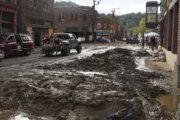Three-year-old Hannah came home from school with a question. Her teacher had placed a frozen bowl of water and plastic animals on the table and the class saw it thaw. But how did it freeze in the first place?
The question prompted experiments at home, with bowls placed in the refrigerator, the freezer and out in the kitchen. It made Judy Hallinen, her grandmother, laugh and it illustrated a point.
“These at-home experiments set kids up to understand how the world works,” says Hallinen, the assistant vice provost for educational outreach and director of the Gelfand Center at Carnegie Mellon University.
Hallinen and other education experts say STEM activities for kids, the hands-on projects that can be done in a classroom or at home, are key to nurturing the idea that science, technology, engineering and mathematics are relevant in everyday life.
“It’s never too early to start to engage young children in science and STEM,” says Erika Shugart, executive director of the National Science Teaching Association. “Resources and activities inside and outside the classroom that engage young learners, such as examining interesting objects, taking field trips and participating in STEM activities, build interest.”
“Unfortunately, the average elementary classroom devotes less than 20 minutes per day to science, but nearly 90 minutes to English language arts and nearly one hour to mathematics,” Shugart says. “For many students, limiting early science learning opportunities in elementary school leaves them unprepared for science and STEM courses in middle and high school. It is important that we emphasize the value of science and STEM education, especially at the elementary level.”
[Read: How to Handle Bullying at School.]
STEM Activities at Home
STEM activities are creative experiments and projects that can teach real scientific principles in a fun, hands-on way. Here are some examples:
DIY engineering
Created at the Gelfand Center, the Bridge Building Challenge explores engineering ideas. Use a range of materials — spaghetti noodles, marshmallows, toothpicks, gumdrops and more — to find out which designs hold up best or bear the most weight. The center suggests you photograph the designs before testing, which sometimes destroys them. Also, “Students should be reminded not to eat any of the bridge-building components, if edible materials are used.”
Cloud in a jar
This activity comes from the Gift of Curiosity website and teaches about water cycles, condensation and states of matter. Pour hot water in a jar. Swirl it around to warm up the sides of the jar. Place a lid on top of the jar and several ice cubes on top of that lid. Leave it for about 20 seconds. Remove the lid and spray hairspray in the jar, then replace the lid and watch the clouds form!
Fibonacci Numbers
Fibonacci numbers, mathematical patterns found often in nature, are fascinating. They are not normally taught in lower grades, but they are easy for elementary school-aged children to understand. Counting the number of spirals in the yellow center of a daisy, for example, or the spirals in a pinecone are good ways to explain them. Mensa for Kids has more ideas.
Oil spill cleanup
This activity teaches how oil spills impact the environment and how chemical and environmental engineers play a role. Use trays filled with a few inches of water, feathers, straws, cotton balls and sponges. Add some oil. Students can devise strategies to get oil off a feather and other “wildlife” in their “ocean.” Read more in this post by the Coalition for Science After School.
Crystal garden
Homeschool Hub explains how to use Epsom salts and food coloring to grow crystals in a jar. Use an equal ratio of salt and hot water and mix them in a glass jar. Add food coloring to color the crystals. Put the mixture in the refrigerator and check in a few hours to see a crystal surprise.
Build a catapult
STEM Activities for Kids explains how to build catapults from frozen pop sticks, rubber bands and other materials. Then, see how far mini pumpkins can fly by measuring the distance. The biggest problem may be what to do when they soar past the end of the tape measure.
Create a balance scale
This activity helps early learners explore weight. Hands on as We Grow explains how to use some plastic hangers, cups and string to make hanging balances that students can use to compare the weight of different objects. Have the students ask questions such as, “How many LEGOs does this toy car weigh?”
Build with jelly beans
A pile of jelly beans (or marshmallows or candy corn) and toothpicks is all that is needed to start learning about structures and engineering. Connecting the toothpicks with jelly beans helps teach kids how shapes and designs work. The activity teaches the concepts behind structural engineering. Read more at Lemon Lime Adventures.
[Read: Back-to-School Safety Tips.]
Magnetic slime
This project, found on the Frugal Fun website, puts a STEM twist on the homemade slime that is a staple for hands-on, tactile learning. Adding iron oxide powder to the mix gives the slime metallic qualities and allows it to react to strong magnets. Children can make it creep!
Exploring pi
Measure pi by measuring the circumference of an object with a string, and then measure the diameter and divide. No matter how big or small the object, if it is truly round, the answer is pi (3.14). Fun math and geometry games like this are a great way to celebrate Pi Day on March 14 every year. Read more at Scholastic.
Connecting Activities to Learning
Education experts say STEM activities are most useful when they are connected to learning concepts.
Whitney Jackson, a professional development coordinator at the Center for Mathematics and Science Education at the University of Mississippi and former teacher, says that connection is essential.
“I talk to teachers who do fun things, but it is not tied to the content,” she said. “That is usually the piece that is missing, and that’s an important thing.”
The center helps connect STEM experts with classroom teachers to provide demonstrations. Similarly, the Gelfand Center where Hallinen is director also conducts STEM workshops and demonstrations.
Hallinen says it is easy for parents to connect activities to learning if they focus on answering questions as they arise. Experiments often yield more questions, which in turn yield more experiments.
“These can be a fun way to spend an afternoon,” she says. “But if you ask a few key questions, it can really increase the learning.”
[READ: How to Build Digital Literacy for Your K-8 Child.]
Learning More About STEM Activities
There are many resources to learn more about teaching science, technology, engineering and math, and activities that can help children learn. Here are some examples:
— The Ultimate STEM Guide for Kids
— National Geographic Kids Science Lab
Searching for a school? Explore our K-12 directory.
More from U.S. News
Choosing a Summer Camp for Your K-8 Child
First Day of School: What Parents, Teachers Should Know
10 Fun STEM Activities for Kids originally appeared on usnews.com







